Giandel DC TO AC POWER INVERTER PM-3000KAR | Usage Instruction
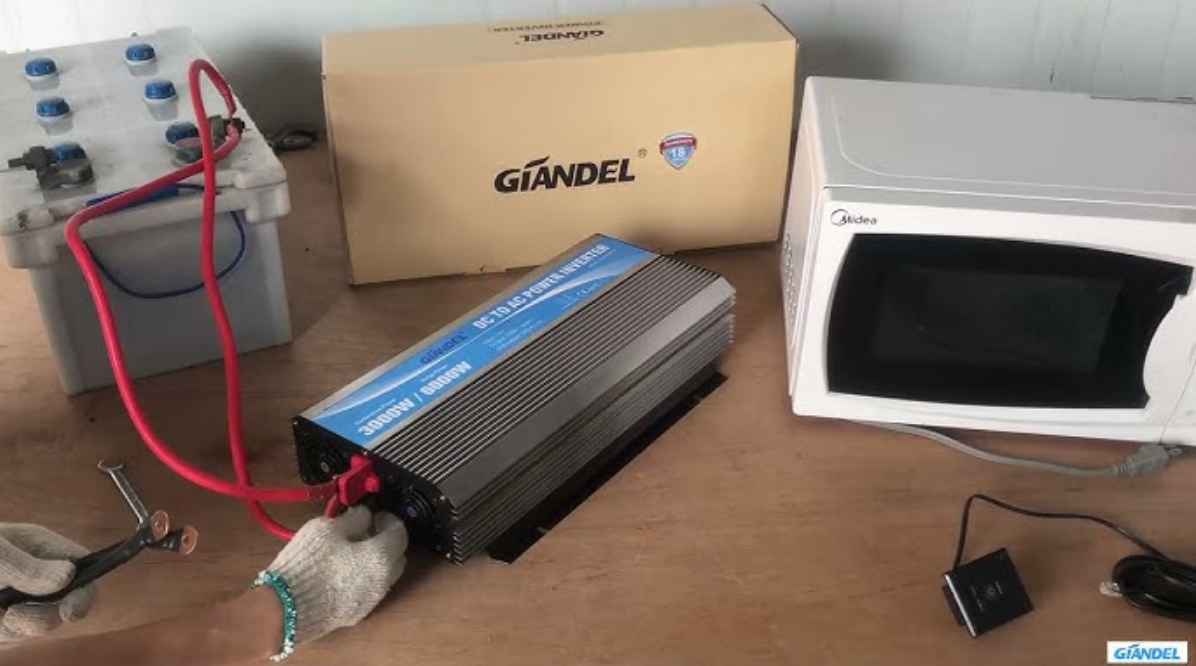
Content

Introduction of Giandel DC to AC Power Inverter PM-3000KAR
The DC to AC Power Inverter PM-3000KAR is a versatile and reliable power inverter that can convert direct current (DC) from your car, boat, or solar panel into alternating current (AC) to power your appliances and devices. With a continuous power output of 3000 watts and a peak power output of 6000 watts, this inverter can handle heavy-duty tasks and provide a stable and clean power supply for your sensitive electronics. The estimated price of the PM-3000KAR is around $250 to $300, and it is now available for purchase in the market.
Specification
Item | PM-1600KAR | PM-1600KAR | PM-2000KAR | PM-2000KAR |
Rated input voltage | 12VDC | 24VDC | 12VDC | 24VDC |
Continuous power | 1600W | 1600W | 2000W | 2000W |
Peak power | 3200W | 3200W | 4000W | 4000W |
Input voltage range | 9.8~16VDC | 19.6~32VDC | 9.8~16VDC | 19.6~32VDC |
Input over voltage shutoff | 16VDC | 32VDC | 16VDC | 32VDC |
Input low voltage shut off | 9.8VDC | 19.6VDC | 9.8VDC | 19.6VDC |
Input low voltage alarm | 10.1VDC | 20.2VDC | 10.1VDC | 20.2VDC |
Output voltage | □100V / □110V / □120V / □220V / □230V / □240V AC±10% (Refer to label) | |||
Output frequency | □50Hz / □60Hz ±1Hz | |||
Output wave | Modified sine wave | |||
Efficiency | ≈90% | |||
Over temperature protection | 65±5℃ | |||
Over load protection | 1800W | 1800W | 2200W | 2200W |
Short-circuit protection | Yes | |||
USBoutput | 5V,2.4A | |||
Noload current | 1A | 0.5A | 1.9A | 0.8A |
Intelligent cooling | The cooling fan won’t work while turning on the inverter, till the temperature of inverter case reach 40℃ or power >40% rated power. | |||
Working temperature | 0~ 40℃ | |||
Storage temperature | -10~ 45℃ | |||
Fuse | 30A×6 | 30A×3 | 30A×8 | 30A×4 |
Weight | 4.2Kg | 4.2Kg | 4.8Kg | 4.8Kg |
Size (L×W×H) | 400×238×96mm | 400×238×96mm | ||
Item | PM-2500KAR | PM-2500KAR | PM-3000KAR | PM-3000KAR |
Rated input voltage | 12VDC | 24VDC | 12VDC | 24VDC |
Continuous power | 2500W | 2500W | 3000W | 3000W |
Peak power | 5000W | 5000W | 6000W | 6000W |
Input voltage range | 9.8~16VDC | 19.6~32VDC | 9.8~16VDC | 19.6~32VDC |
Input over voltage shutoff | 16VDC | 32VDC | 16VDC | 32VDC |
Input low voltage shut off | 9.8VDC | 19.6VDC | 9.8VDC | 19.6VDC |
Input low voltage alarm | 10.1VDC | 20.2VDC | 10.1VDC | 20.2VDC |
Output voltage | □100V / □110V / □120V / □220V / □230V / □240V AC±10% (Refer to label) | |||
Output frequency | □50Hz / □60Hz ±1Hz | |||
Output wave | Modified sine wave | |||
Efficiency | ≈90% | |||
Over temperature protection | 65±5℃ | |||
Over load protection | 2700W | 2700W | 3200W | 3200W |
Short-circuit protection | Yes | |||
USBoutput | 5V,2.4A | |||
Noload current | 1.75A | 0.8A | 2.2A | 1.2A |
Intelligent cooling | The cooling fan won’t work while turning on the inverter, till the temperature of inverter case reach 40℃ or power >40% rated power. | |||
Working temperature | 0~ 40℃ | |||
Storage temperature | -10~ 45℃ | |||
Fuse | 30A×10 | 30A×5 | 30A×12 | 30A×6 |
Weight | 5.4Kg | 5.4Kg | 6.2Kg | 6.2Kg |
Size (L×W×H) | 505×238×96mm | 555×238×96mm | ||
PARTS LIST
Back panel
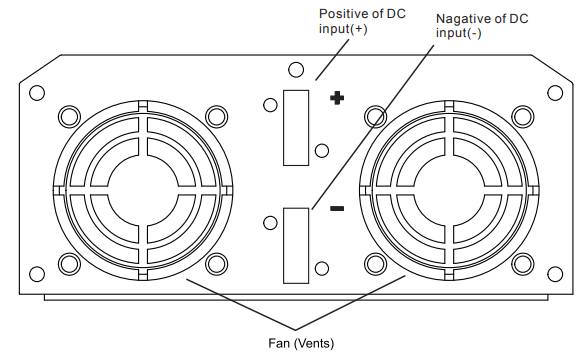
Front panel
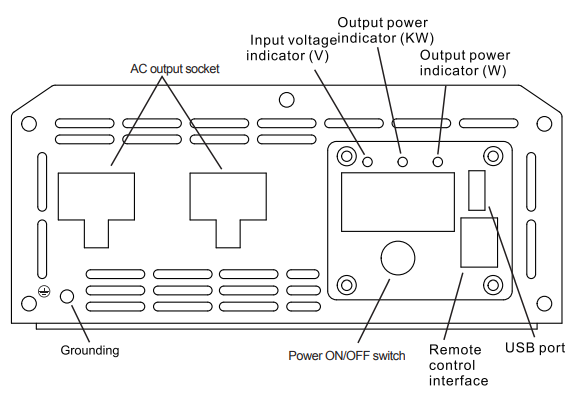
Remote controller box
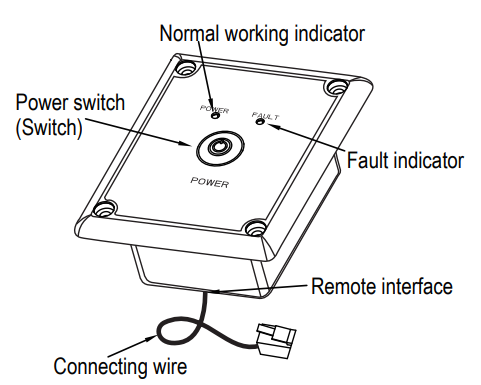
Description
The PM-3000KAR is a pure sine wave inverter that can produce clean and stable AC power, just like the power you get from your wall outlet at home. It has a wide input voltage range of 10-15V DC for 12V systems and 20-30V DC for 24V systems, making it compatible with various DC sources. The inverter also has overvoltage, undervoltage, overload, and short-circuit protection to ensure safe and reliable operation. The Giandel DC to AC Power Inverter PM-3000KAR has two GFCI AC outlets and one 30A twist-lock outlet for connecting various devices and appliances. It also has a digital display that shows the input voltage, output voltage, and output wattage.
Setup of Giandel DC to AC Power Inverter
To set up the Giandel DC to AC Power Inverter, follow these steps
- Connect the inverter to your DC source, such as your car battery or solar panel, using the appropriate cables and fuses.
- Turn on the power switch of the inverter and check the input voltage and output voltage on the digital display.
- Connect your devices and appliances to the AC outlets of the inverter.
- Check the output wattage on the digital display and adjust the load accordingly.
- Turn off the inverter when not in use to save energy and prolong its lifespan.
Brief
Our power inverter is an advanced tool of power conversion, and it can supply you with AC power converted from DC power source. Not only can be used in cars, vessels and camping, but also can be used in emergency the power fails.
In order to use the inverter efficiently and safely, please install and use it in a proper way. Please read the instruction carefully before installing and using the appliance.
Warning and safety
- Read the manual before use and keep it for future reference.
- Don't put the inverter under sunlight, near a heating source, wet or humid environment.
- The case housing of inverter will be hot when using, please keep the inverter away from material which can't withstand high temperature, such as clothing, sleeping bags, carpets etc.
- Our power inverter is designed to use with the negative ground electrical system! Don't use with positive ground electrical systems (The majority of modern automobiles, RVs, trucks and boats are negative ground).
- Do not disassemble the unit; it may cause fire or electric shock.
- Keep the inverter out of reach from children.
- The power inverter will output AC power as utility power, please treat the output terminal as carefully as your home AC socket. Don't put any other things into the output terminal except electrical appliance plug.
- Always stay alert during the operation, it is better not to operate alone, to ensure you get help while needed.
Assemble
- The position of Mounting
First ensure that there is enough space to install the inverter, while the installation location must meet the following requirements- Drying: Do not use water or other liquids dripping on the inverter
- Cool: a working environment temperature of the product is 0-40℃, preferably a temperature of 10-25℃, at a temperature as low as possible within this range
- Ventilation: There should be a certain distance between inverter and other objects, to avoid blocking the products vents.
- Clean: Do install the products in the dusty, wood chips or other particles , If cooling fan is turned on, the particles involved in the inside of the product, thus affecting the normal work.
- While inverters and batteries connected, will produce arcs or sparks, so there should not be around flammable objects such as gasoline, alcohol, etc.
- Assemble the inverter
For this big power inverter, because of the heavier weight, preferably mounted on a solid platform, such as floor, table or mounting bracket fine. In order to avoid falling off, platform for supporting the product should can bear the weight of sufficient capacity, and it is good with four screws to secure the product.
Note: In case not connected to the remote box, the product can also be used as a normal modified sine wave inverter as normal.
Using time of battery
- Current and voltage:
The battery is used to supply the DC input voltage required by the product, and its rated voltage must be in line with the rated input voltage of the inverter, beyond the input voltage range of the inverter, and the cross connection will cause the product to be under voltage or under voltage protection. At the same time, the battery must provide enough current for inverter, a small capacity battery is not able to drive high power appliances, in this case, usually due to excessive current and battery discharge the battery terminal voltage low, undervoltage protection products appear The simple formula for the battery current is the load power / the battery voltage. As the inverter itself will be part of the loss, so the actual current will be greater than this value of about 10%. For example: the battery voltage is 12VDC, the load power is 400W, then the actual current size of the battery is about 400W÷12Vx110%=37A - Battery working time
The using time of battery depends on battery capacity (AH) and the power of the connected load (W), the calculating method is: Time (hours) =battery capacity (AH) × battery output voltage (V) x efficiency rate ÷ electrical power of using (W) such as the 12V DC input inverter uses the 12V battery, if the battery capacity is 200AH and at this time the inverter is driving 400W power load, the efficiency rate is 90% when the battery is full, according to the formula above, the battery use time =200(AH)÷(400÷12x110%) = 5.4 (Hour). This means the battery can be used for 5.4 hours.
Notice: The nominal battery capacity is the discharge capacity in 20 hours discharge rate ,under the condition when the discharge current exceeds this value, the discharge capacity will be reduced, the corresponding discharge time will be shortened than the calculation value, this part of the specification can refer to battery manufacturer,and whether the battery fully charged will also affect the results.
CONNECTION
- Grounding
The power inverter has a terminal on the back panel marked "Grounding" or " ". This is used to connect the chassis of the power inverter to the ground.
". This is used to connect the chassis of the power inverter to the ground.
The ground terminal has already connected to the ground wire of AC output receptacle through the internal connecting wire. The ground terminal must be connected to the ground wire, which will vary depending on where the power inverter is installed. In a vehicle, connect the ground terminal to the chassis of the vehicle. On the ship, connect the ground terminal to the ship grounding system; In a fixed position, connect the ground terminal to the earth.
Warnings- To ensure the firmness of the connection. The ground wire must be 14AWG ( 2.08mm2 ) or even larger.
- Do not operate the power inverter without connecting to ground. Electric shock hazard may result.
- Connect to the battery
- Please do all the safety precautions before connection, then check whether the battery voltage is in accordance with the input voltage of the inverter. Only the voltage of battery according with the requirements can be allowed to connect with the inverter.
- The connecting wire must be big enough to bear current, or else the inverter can not support big load because of voltage reduce caused by the small cross-sectional wire. Depending on the below table, please select the input DC wire or larger one.
Inverter Input voltage | Rated power | Max current of cable | Specification of wire length≤1m | Specification of wire length1-2m | Specification of wire length≤N m |
12V | 1000W | 100A | 6AWG (13.3mm2) | 3AWG (26.67mm2) | N×6AWG (N×13.3mm2) |
1500W | 150A | 4AWG (21.15mm2) | 1AWG (42.41mm2) | N×4AWG (N×21.15mm2) | |
2000W | 200A | 3AWG (26.67mm2) | 0AWG (53.49mm2) | N×3AWG (N×26.67mm2) | |
2500W | 250A | 2AWG (33.62mm2) | 00AWG (67.43mm2) | N×2AWG (N×33.62mm2) | |
3000W | 300A | 1AWG (42.41mm2) | 000AWG (85.01mm2) | N×1AWG (N×42.41mm2) | |
24V | 1000W | 50A | 9AWG (6.63mm2) | 6AWG (13.3mm2) | N×9AWG (N×6.63mm2) |
1500W | 75A | 7AWG (10.55mm2) | 4AWG (21.15mm2) | N×7AWG (N×10.55mm2) | |
2000W | 100A | 6AWG (13.3mm2) | 3AWG (26.67mm2) | N×6AWG (N×13.3mm2) | |
2500W | 125A | 5AWG (16.77mm2) | 2AWG (33.62mm2) | N×5AWG (N×16.77mm2) | |
3000W | 150A | 4AWG (21.15mm2) | 1AWG (42.41mm2) | N×4AWG (N×21.15mm2) |
Notice
- The above table is only for your reference. In practice, the thick wire can be replaced by two thin parallel wires if only the total section acreage of the wire meets the requirements.
- In high current, the input DC wire may produce voltage drop, therefore,the operating voltage should be subject to the value on the terminals. If the voltage drop is too large, it can increase the acreage of the section or reduce the length of the lead. The recommended length of lead is less than 1m.
- Connect cathode wire of the battery to the cathode terminal (black) on the back panel of inverter and then connect the anode wire of the battery to the anode terminal (red) on the inverter, and fix them.
Warnings
- Please wear eye patch and work clothes when working around the battery to avoid the acid and corrosive objects harm your eyes and skin.
- Prepare enough water and soap. In case the acid materials contact eyes or skin, clean it by soap and water as soon as possible. If the acid materials spay to your eyes accidentally, clean it by cold water immediately and then sent to hospital.
- Do not put any combustible material in the location of installation for spark will result when it is connected to the battery.
- Keep good ventilation. The battery may produce a little inflammable gas when it works, so keep away from the inverter and it is better to install them in different space.
- Fix the connecting wire of the input DC, or it will result the over-reduction of the voltage or over-temperature of the wire.
- A reverse connection of the polarities or the short circuit will burn the fuse or result the permanence damage of the internal elements of inverter.
- Take away the metal accouterment, such as ring or watch, when installation to avoid the short circuit.
- Although there is over-voltage protection, it may also cause damage of the inverter if the input voltage is too high.
Connection of the AC appliance
Put the power plug of the AC appliance load into the output AC receptacle ofthe inverter directly.
Warnings
- Make sure that the switches of the inverter and appliance power are in OFF position before connection.
- Check the power cord. If it is damaged, it should be connected after replacement.
Each outlet of the inverter has a given current rating of the manufacturer. It shall not exceed this value during use. Otherwise, the socket may be damaged by overheating and may cause an electric shock. The maximum output power of a single socket is shown in the following table
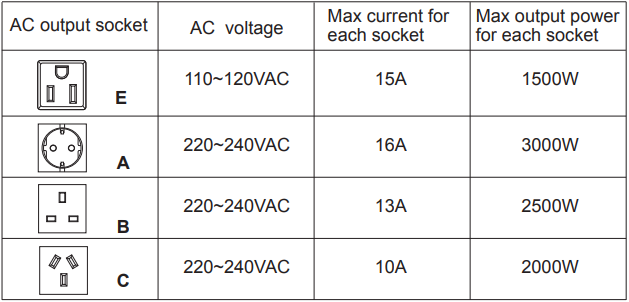
Assemble the remote control box
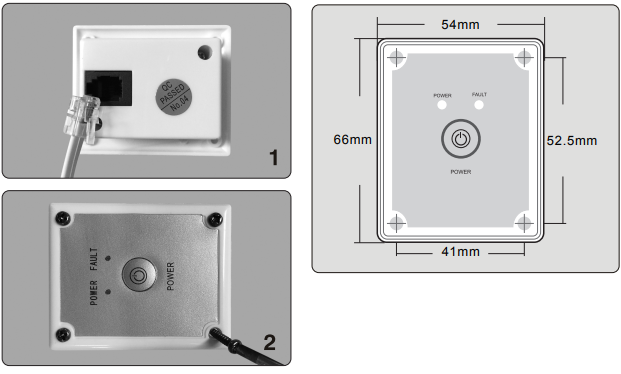
- The remote is designed to be mounted on a dash or other surface where a hole should be cut so that it sits flush. T his is not a requirement however just a recommendation.
- The remote cable should be plugged into inverter and the remote before mounted.
Usage of inverter
- How to use an inverter
- Check the output voltage and capacity of the battery to make sure it applicable to the requirement of the product use.
- Connect the battery and the DC cable of the inverter to ensure that the polarities do not be reversed and in good contact.
- Long press the switch of inverter or of remoter for over 0.5s and later on let it go, if the indicator lighter on the inverter or on the remoter box is on,it means that the inverter start to work normally. This method can avoid effectively turning on the unit due to the interference or any mistakes.
- Switch off electrical appliances and put electrical appliance plug to the AC output socket of inverter. And then switch on electrical appliance for using.。
- The cooling fans inside the inverter do not work when the unit power on. It doesn't run until the case temperature rise up to 40℃.
- Switch off inverter and remoter to stop working. At that time, the indicator lights in both inverter and remoter are off. The inverter does not consume current from battery when it switched off
- How to use USB outlet
The USB outlet can provide stable 5V DC voltage; the maximum current is 1000mA (2400mA), which can directly provide power for the portable device with USB port. Notice: Before use the USB power supply, please make sure the device can be charged by USB and the maximum working current is no more than 1000mA (2400mA). - How to use solar charging
- Firstly connect the battery correctly, switch to the correct battery types(Lead Acid of GEL)
- Connect the solar panel’s positive and negative electrode to the positive and negative terminal of the solar input of inverter, pay attention to the correct polarity.
- Normal charging panel quantity of electric charge indicator lights light up, the user can know the size of the battery charging voltage, when the "full" indicator lights up, indicating that the battery is fully charged, the user should promptly disconnect the solar cell and product connected to stop charging, avoid overcharge. Notice: It will destroy inverter when solar charging input voltage too high, so please choose the working voltage 15V-18V, open voltage≤22V, power 600W solar panel.
Operational principle
- The inverter converts DC to AC, conversion process is divided into two steps, the first step is to convert low voltage DC to high voltage DC , the second step is using the full bridge converter tech to convert high voltage direct current into alternating current.
- The conversion circuit adopts advanced power device and high frequency power conversion technology. Compared with the traditional inverter using the power frequency transformer, it has the characteristics of small size, light weight and high conversion efficiency etc.

OUTPUT VOLTAGE AND WAVEFORM
The output voltage waveform of the inverter is called "quasi sine wave" or "modified sine wave", it is a step waveform similar like household alternating current , this type of waveform is applicable to most of the load, including linear or switching power supply, transformer, electric motor etc. Since the output voltage waveform of the inverter is different from AC, RMS with general analog or digital multimeter can not accurately measure the output of the inverter, please use the true RMS digital multimeter to measure, such as FLUKE 177/179 multimeter.

About soft start technology
This inverter has advanced soft start function. The output voltage rises up from low to normal when the inverter is turned on.
- This can reduce high startup currents, which can make startup easier for large inductive loads.
- As for the large inductive loads, such as electric tools and capacitive loads, We suggest turning on the switch of the appliance firstly and thenthe inverter's. The soft start .May be enough to power the high staring.
Working indication
When the product is working, the digital tube will alternately display the input voltage and the output power. When the product enters the protection state, the digital tube the current state of protection, as shown below:
- Input(V) LED is on, digital display is the value of the input voltage
- Output(KW) LED is on, digital display is the value of the output power
- Output(W) LED is on, digital display is the value of output power
- Digital tube shows LO, indicates the current status of undervoltage protection
- Digital tube shows HI, indicates the current status of overvoltage protection
- Digital tube shows OL, indicates the current status of output overload or short-circuit protection
- Digital tube shows OH, indicates the current status of overheat protection.
Protection Features
- Input under-voltage alarm: When the input DC voltage is lower than 9.8V (19.6V/39.2V), the buzzer will whistle intermittently to remind that the inverter will go into the under voltage protection. Pay attention to save the data if you are using computer.
- Under voltage protection: The inverter will automatically shut down when the input DC voltage is lower than 9.5V(19V/38V).The buzzer will whistle continuously and the green light is off, red light is on. Please turn off the inverter and use it after recharging the battery.
- Over voltage protection: The inverter will automatically shut down when the input DC voltage is higher than 16V(32V/62V).The buzzer will whistle continuously and the green light is off, red light is on. Please turn off the inverter and adjust the input voltage to the admissible range.
- Overload protection: The inverter will automatically shut down when the load is higher than the rated power. The buzzer will whistle continuously. Turn off the inverter and resume to normal operation after taking away the excessive load.
- Short-circuit protection: The AC output will be automatically shut down when short circuited. It will automatically reset after the problem is solved.
- Thermal protection: The unit will get bot during operation. If the temperature is higher than 149°F, the inverter will automatically shut down. Then the buzzer will whistle continuously and the green light is off, red light is on. Please turn off the inverter, and continue using it after the temperature goes back to normal naturally. Meanwhile find out the factors causing the fault, such as ventilation, ambient temperature, vent, load power and so on. It can avoid similar things from happening again.
HOW TO CHANGE FUSE
- Firstly disconnect the inverter and external batteries, solar panels, load etc all the connections.
- Unscrew the side plate screws and pull out the bottom plate.
- Use pliers to clamp car fuse inside the product, and pull out .
- Replace the same specifications of the car fuse, and then install the bottom and side panels, and screw well.

Failure guidelines
| Fault/Display | Cause | Solution |
|---|---|---|
| Low input DC voltage | Recharge or replace the battery. | |
| High input DC voltage | 1. Do not use when the battery is charging. | |
| 2. Check the rated voltage of the battery | ||
| and make sure that it is in the allowable | ||
| range of the input voltage. | ||
| Overload | Reduce the load power. | |
| No output voltage, | Over temperature | 1. Cut off the load and allow cooling for 10 |
| buzzer whistles | to 30 minutes. Restart after it reaches | |
| continuously | normal temperature. | |
| 2. The load power is too large. Reduce the | ||
| total load power to the range of rated power. | ||
| 3. Avoid blocking the vent and improve the | ||
| ventilation condition. | ||
| 4. Reduce the ambient temperature. | ||
| No output voltage | 1. The switch is off. | 1. Turn on the power switch. |
| 2. The battery lead | 2. Check the connections and make sure | |
| doesn't connect well. | connect well. | |
| Incorrect output | 1. Measured using | 1. Use a true RMS multimeter to measure, |
| voltage | true RMS multimeter. | such as model FLUKE 177/179. |
| 2. The battery power | 2. Check the rated voltage of the battery | |
| is low. | and make sure that it is in the allowable | |
| 3. The input voltage is | range of the input voltage. | |
| too high or too low. | ||
| Cannot drive the load | 1. Load power is too | Reduce the load power, or turn on the |
| large, or the actual | electrical appliance, then turn on the | |
| power of the appliance | inverter. Use the internal soft-start circuit | |
| exceeds nominal power. | of the inverter to buffer the start. | |
| 2. The starting power | ||
| of appliance is larger | ||
| than the rated | ||
| power(such as motor) | ||
| While using with TV | Disturbance | 1. Keep the inverter far from antenna. |
| or audio, there is | 2. Use screened antenna. | |
| snowflake or noise | ||
| from the audio. |
If all of the above methods have been tried, the product still not works properly. The internal circuit of the product may be out of order. Please return the product to the supplier for maintenance.
Pros & Cons
Pros
- High power output for heavy-duty tasks
- Pure sine wave output for clean and stable power
- Wide input voltage range for compatibility with various DC sources
- Overvoltage, under voltage, overload, and short-circuit protection for safe operation
- Digital display for monitoring the input and output status
Cons
- Bulky and heavy for portable use
- May produce noise and heat during the operation
- Requires proper installation and maintenance for optimal performance
- May not be compatible with some sensitive electronics that require a stabilized power supply
- Has a limited warranty and customer support
Customer Reviews of Giandel DC to AC Power Inverter PM-3000KAR
Customers who have used the DC to AC Power Inverter PM-3000KAR generally have positive reviews about its performance and reliability. They appreciate its high power output and pure sine wave output, which can power various devices and appliances without any issues. However, some customers complain about its bulky and heavy size, which makes it difficult to carry around. Some customers also report that the inverter produces noise and heat during operation, which may affect its longevity and efficiency. Overall, the PM-3000KAR is a recommended power inverter for those who need a stable and powerful AC supply for their off-grid or emergency power needs.
Faqs
What distinguishes a pure sine wave inverter from a modified sine wave inverter?
How many devices is the Giandel PM-3000KAR compatible with?
Can I power my camper or RV with the Giandel PM-3000KAR?
How much time is the Giandel PM-3000KAR good for?
If the Giandel PM-3000KAR turns off on its own, what should I do?
Can I use an uninterruptible power supply, or UPS, with the Giandel PM-3000KAR?
How should I take care of my Giandel PM-3000KAR?
How should I ensure that I take the necessary precautions when using the Giandel PM-3000KAR?
The Giandel PM-3000KAR: Is it appropriate for usage in the great outdoors?
What is the Giandel PM-3000KAR's warranty?
Leave a Comment
